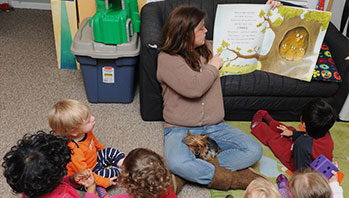- garden
- ground
- grow
- plant
- seed
- soil
- sprout
MA Standards:
English Language Arts/Literature/RL.PK.MA.1: With prompting and support, ask and answer questions about a story or a poem read aloud.
English Language Arts/Literature/RL.PK.MA.9: With prompting and support, make connections between a story or poem and one’s own experiences.
MA Draft STE Standards:
Life Sciences/Ecosystems; Biological Evolution/LS2/4.B: Using their experiences in the local environment and other evidence, raise and discuss questions about the basic needs of familiar organisms and how they might meet their needs. (Clarification statement: basic needs include water, food, air, shelter, and light for most plants)
Head Start Outcomes:
Literacy Knowledge/Book Appreciation and Knowledge: Asks and answers questions and makes comments about print materials.
PreK Learning Guidelines:
English Language Arts/Reading and Literature 10: Engage actively in read-aloud activities by asking questions, offering ideas, predicting or retelling important parts of a story or informational book.
Read Together: Jack’s Garden #1

© Commonwealth of Massachusetts, Department of Early Education and Care (Jennifer Waddell photographer). All rights reserved.
STEM Key Concepts: Plants start in different ways; Some plants start from seeds; Some plants start from bulbs; Plants grow in many places; Plants need water, food, and sunlight to grow; Plants have different parts: roots, stems, leaves, and fruit; Plants grow in places where they get their needs met; Plants often grow in some type of dirt
ELA Focus Skills: Active Listening, Concepts of Print, Interpreting Illustrations, Listening and Speaking, Parts of a Book, Story Comprehension, Vocabulary
Educator Prep: Jack’s Garden is a story about the many changes a garden goes through as it grows. There are many pictures and ideas to discuss in the story, so you may want to read only part of the story at the first sitting. You can revisit the book over the weeks as children’s plants and gardens continue to grow or you may want to flip through the remaining pages if you have time.
Tell children you are going to read a story about a boy who plants seeds in a garden.
Hold up the book cover. Point to and read the title and author. Ask if children recognize any letters in the title. Then ask them to name things they recognize in the illustration.
Before You Read
Explain to children that a garden is a space where peoplegrow plants. Say, Gardens can be planted in boxes, other containers, or in the soil or ground.
Open to the title page and hold up the illustration. Ask, Were do you think Jack plants his garden in the story? Why do you think that?
- Talk about why people grow gardens. (food to eat, flowers to look at, or homes for birds and other animals)
- Ask children if they have ever seen a garden or helped plant a garden. Allow time for them to share.
- Set a reading focus for children by having them notice how the needs of the plants are being met.
As You Read
Read slowly and with expression. Pause occasionally to ask questions.
- Pause on the first spread and ask, Why do you think there are no rocks, trees, or other things inside the fence?
- Pause on the spread with the worms. Ask children what they know about worms. Point ta worm tunnel and explain that when worms move around and make tunnels, they help make the hard soil softer so water and air can get to the plants.
- Pause on the page with the seed packets and ask, What do you think Jack is sprinkling in the soil? Why do you think the soil is in rows? (make room for the plants to grow)
- Pause on the page with the rain and ask, What do you think will happen to the puddle of rain between each row? (seep into soil where seeds are planted)
- Pause on the page with the seedlings and ask children talk about the different plants. Ask, Why do you think you can't see the seeds or roots?
After You Read
Talk about the book with children. Ask questions such as,
- How do you think Jack’s seeds will get what they need to grow?
- What if there were no rain for a few days; how do you think the seeds might get the water they need?
- Have you ever helped plant a garden? How did you help it grow?
If time allows, you may want to flip though the remaining pages. Turn to the final spread of the book to show children Jack’s full-grown garden.
